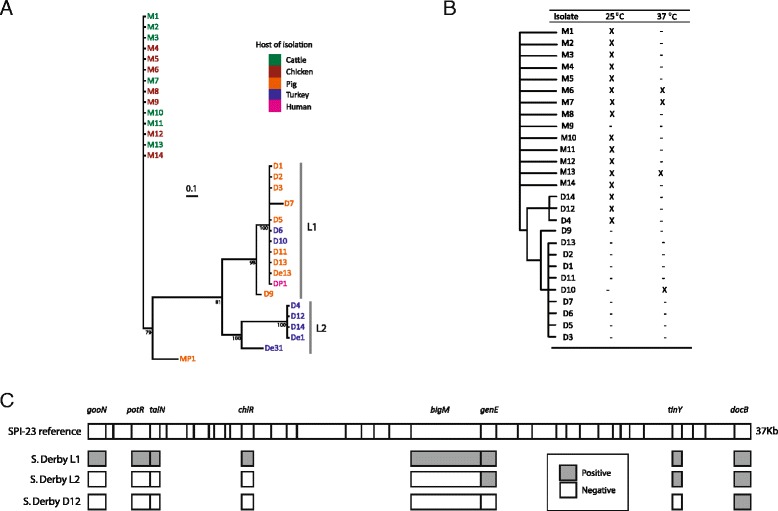Fig. 1.

Phenotypic and genotypic differences between S. Derby and S. Mbandaka isolates. a Phylogenetic reconstruction of S. Derby and S. Mbandaka UK and public ST types. UK isolations of S. Mbandaka form one single clonal population with the public isolate MP1 clustering out from the group. Whereas S. Derby is formed of two distinct lineages, L1 (UK isolates D3, D5, D6, D7, D9, D10, D11, D1, D2, D13 and public isolates De13 and DP1) and L2 (UK isolates D4, D12, D14 and public isolates De1 and De31). The branch lengths represent the average number of SNPs per partition. Bootstrap values are the mean of the prior probability densities for each node. The first 3000 trees were discarded, the consensus tree was summarised from the remaining 6237 trees, leaving an effective sample size of 451, a stable solution of −5088 and a standard error of the mean of 16.75. Bootstrap values are the mean of the prior probability densities, the branch lengths represent the average number SNPs per partition. b Presence and absence of SPI-23 genes and SPI-1 region 1 and 2 in relation to a phylogenetic cladogram. All S. Derby L1 isolates lack SPI-1 region 1 and 2, and contain a full version of SPI-23. L2 isolate D12 contains the SPI-23 genes genE and docB as well as SPI-1 region 1 and 2. S. Derby L2 isolates D4 and D14, both contain SPI-1 region 1 and 2 and lack all of SPI-23 with the exception of docB. c Variation in biofilm formation. All S. Mbandaka isolates with the exception of M9 formed a biofilm at 25 °C within 48 h. S. Derby L2 isolates formed biofilms at 25 °C, only one L1 isolate, D10, formed a biofilm, this was at 37 °C
